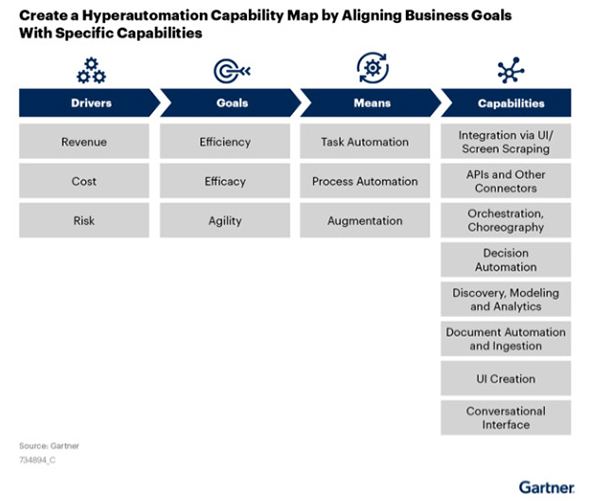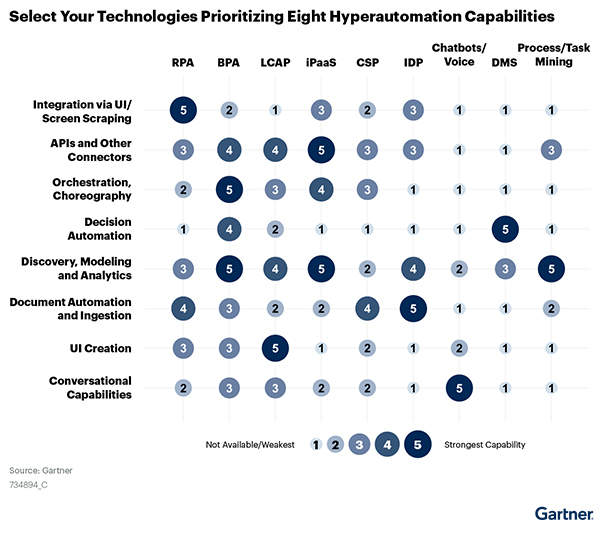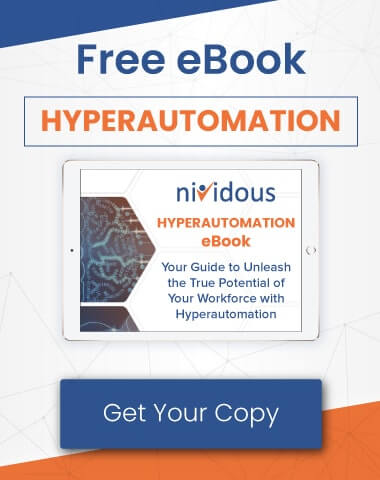“The real challenge — to scale beyond the initial few low-hanging fruits of routine processes — cannot be solved by a single tool or with siloed strategies. Without the right portfolio of technologies, a decision framework and prioritization of use cases, software engineering leaders will be unable to optimize organizational efficiency, efficacy and agility,” as per Gartner.*
Software engineering leaders are often pressured to deliver immediate value using Robotic Process Automation (RPA) that relies on automation only at the task level. However, this siloed automation, often does not scale up to deliver the long-term, strategic benefits of Hyperautomation.
Hyperautomation – a holistic and disciplined approach towards automation – involves a set of automation technologies that are effectively orchestrated to deliver end-to end intelligent automation.
This approach underscores the need to move beyond tactical, task-based automation and automate all business processes that can or should be automated.
Not all business processes are simple, rules-based, and short-running processes. Many processes include complex business rules, human-led decision-making, and continuous optimization. To automate complex processes at an enterprise level, businesses must expand beyond siloed choices like RPA to build a strategic technology portfolio that delivers Hyperautomation.
But the overlapping capabilities and marketing hype of numerous automation technologies have made it difficult for CIOs to choose the best combination of technologies to deliver Hyperautomation.
In this blog, we will talk about key frameworks that are recommended by Gartner to build an effective Hyperautomation portfolio. Here are the three considerations:
- Building a Hyperautomation capability map by aligning your business goals
- Selecting technologies by prioritizing key hyperautomation capabilities
- Key considerations to be able to make smart technology decisions
Building a Hyperautomation Capability Map:
A Hyperautomation capability-mapping exercise should start with a business framework that examines your organization, its goals, and strategies to deliver on those goals. The planning phase is often completed in stages such as:
Setting the objectives
Determine key outcomes and identify key metrics to measure those desired outcomes. Once you determine your outcomes, let’s say improved efficiency and agility, prioritize your automation use cases accordingly that can deliver these outcomes.
Discovering and analyzing automation opportunities
To effectively identify automation opportunities, align your use cases under three broad categories of automation – Task automation, Process automation, and Augmentation. Are the processes simple and involve routine tasks, or are they more complex, or do you need to enable self-service solutions –ask these questions and prioritize use cases.
Identifying suitable technologies that can deliver the expected outcomes
Technology capabilities are the key ingredients for building the Hyperautomation portfolio. Each technology has different core characteristics and hence their capabilities are different. In the following graphics, Gartner highlights eight key capabilities that are required to support Hyperautomation goals.
Choosing The Right Set of Technologies:
Selecting the right set of technologies is not about simply comparing one tool to another tool. Rather, businesses should focus on determining the best combination of complementary technologies.
To build an effective technology portfolio, you must prioritize the capabilities required for each hyperautomation initiative, and then evaluate the products and technology features that optimally align with those needs.
Check the following figure that illustrates the technology evaluation criteria driven by eight key hyperautomation capabilities.
Four Key Considerations While Making Technology Decisions:
It is essential also to consider the following four criteria apart from evaluating automation technologies for their fit with your business goals.
- Time-to-value constraint – A trade-off between tactical and strategic value to find the best balance.
- Total cost of ownership (TCO) – Determining if your TCO for the selected automation tool is justified against the total budget.
- Skills requirements – Check if your organization has the talent or capability to build, support, and
maintain automation using the selected set of technologies. - Vendor maturity – Evaluate the platform, and its capabilities offered by the vendor and decide if their solution aligns with your enterprise architecture.
Are you set to create an optimal portfolio of Hyperautomation technologies?
Nividous intelligent automation platform can help you in achieving the greatest business value from Hyperautomation.
*Beyond RPA: Build Your Hyperautomation Technology Portfolio, Saikat Ray, Paul Vincent, Keith Guttridge, Frances Karamouzis, 22 October 2021
GARTNER is a registered trademark and service mark of Gartner, Inc. and/or its affiliates in the U.S. and internationally and is used herein with permission. All rights reserved.






![The Path Forward for Intelligent Automation [2024 Trends] Blog Feature](https://nividous.com/wp-content/uploads/2024/05/The-Path-Forward-for-Intelligent-Automation-blog-feature-1.webp)
